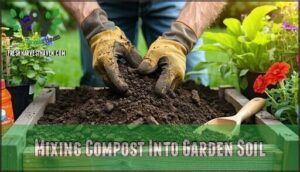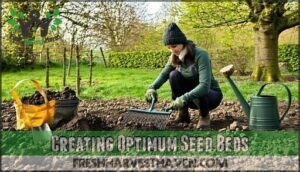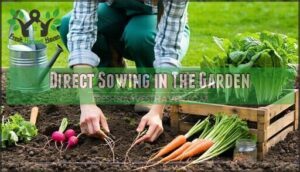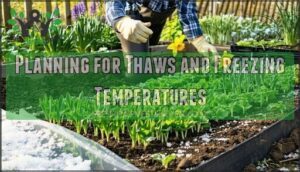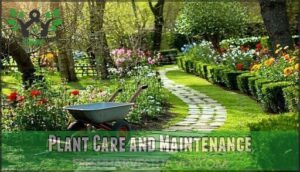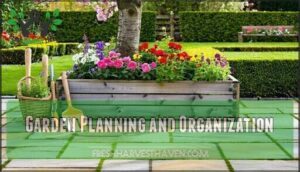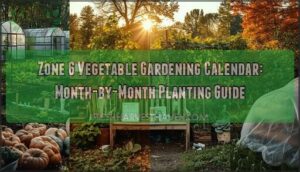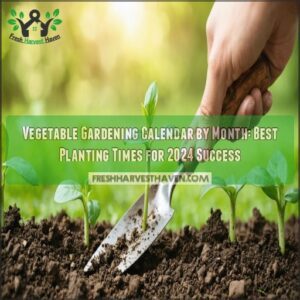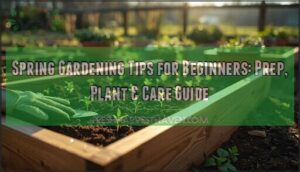This site is supported by our readers. We may earn a commission, at no cost to you, if you purchase through links.

You’ll want to assess winter damage first—frost heave affects 30% of perennial beds, while 42% of woody plants suffer branch breakage from snow loads.
Start by removing debris and pulling weeds before they establish deep roots.
Clean your tools and apply fresh mulch to suppress weeds.
Check for animal damage like gnawed bark or disturbed mulch, then repair fencing as needed.
Prepare your soil by adding two inches of compost per six inches of soil, testing pH levels to guide fertilizer applications.
Time these amendments two weeks before planting to allow proper integration—but there’s a strategic sequence that maximizes your garden’s potential.
This sequence is crucial for the entire growing season, and proper planning can help you achieve the best results with fresh mulch.
Table Of Contents
- Key Takeaways
- Spring Garden Preparation
- Soil Preparation Techniques
- Early Spring Planting Guide
- Plant Care and Maintenance
- Garden Planning and Organization
- Frequently Asked Questions (FAQs)
- What should I plant in the early spring?
- What is the 70/30 rule in gardening?
- What is the rule of 3 in gardening?
- What is the 3 year rule in gardening?
- When should I start my garden in the spring?
- What is the gardening 3 year rule?
- What is the most common mistake of first time gardeners?
- What vegetables can I plant earliest in the spring?
- Is April too early to plant a garden?
- What seeds can you plant in early spring?
- Conclusion
Key Takeaways
- Assess winter damage first – Check for frost heave affecting 30% of perennial beds and branch breakage in 42% of woody plants before you start any spring work.
- Clean and prepare strategically – Remove debris, pull weeds while they’re small, and add 2 inches of compost per 6 inches of soil two weeks before planting.
- Plant cool-season crops early – Start peas, spinach, lettuce, and radishes when soil reaches 45°F, weeks before your last frost date.
- Time your tasks with weather – Monitor soil temperature and moisture levels, and protect plants from unexpected late frosts with row covers or cold frames.
Spring Garden Preparation
Early spring marks the perfect time to assess your garden’s condition after winter’s harsh effects and prepare for the growing season ahead.
You’ll want to start by walking through your garden beds to check for frost heave damage, broken branches, and any winter debris that needs clearing before new growth begins, which is crucial for a successful garden.
Inspecting for Winter Damage
Begin your spring garden assessment by systematically checking for frost damage and winter debris.
Look for frost-heaved plants affecting 30% of perennial beds, which need gentle repositioning.
Inspect for branch breakage found in 42% of woody plants after snow loads.
Check root systems for winter damage, as waterlogged soils impact 54% of gardens post-thaw.
Examine hardscaping for soil erosion and structural shifts.
Before planting, consider adding organic matter to improve soil fertility.
This root inspection and dormant pruning assessment sets the foundation for successful recovery and helps in planning for a healthy garden with proper spring garden care.
Cleaning Up Debris and Weeds
Once you’ve assessed winter damage, focus on debris removal and weed prevention to create a clean foundation for spring growth.
Start your garden cleanup by removing fallen branches, dead leaves, and winter debris that can harbor pests and diseases. Pull weeds while they’re small and manageable—early spring weeding prevents them from establishing deep root systems.
Add organic debris to your composting pile for future soil improvement.
- Tool maintenance matters: Clean and sharpen your pruning shears, hoes, and shovels for efficient spring work.
Proper gardening techniques involve using the right pruning shear tools to trim plants effectively.
Apply fresh mulch around existing plants after cleaning to suppress new weed growth and retain soil moisture.
Preparing Hardscaping for Spring
After clearing debris and weeds, turn your attention to hardscaping repairs.
Fence repair and walkway maintenance prevent safety hazards while patio cleaning removes winter grime.
Inspect garden edging for frost damage and reset loose stones.
Clean outdoor furniture thoroughly, checking for rust or wear.
These early spring tasks create a solid foundation for your landscape preparation, ensuring structures support your garden’s growth throughout the season.
Checking for Animal Burrows and Damage
Winter critters often leave calling cards in your garden beds through Burrow Inspection and Damage Assessment. Look for telltale signs like holes, gnawed bark, or disturbed mulch during your spring garden prep routine.
Spring reveals winter’s hidden mischief through tiny holes and telltale tooth marks scattered across your garden beds
Winter’s furry residents always reveal their hideouts through telltale tracks and gnaw marks.
Animal Control becomes essential for effective Wildlife Management in early spring gardening.
- Install motion-activated sprinklers for Pest Prevention without harming wildlife
- Repair damaged fencing and seal entry points you discover
- Apply natural repellents around vulnerable plants for spring pest control
Addressing these issues early protects your garden maintenance efforts while supporting balanced ecosystems.
Soil Preparation Techniques
Your soil’s spring awakening depends on thoughtful preparation that sets the foundation for healthy plant growth all season long.
You’ll transform winter-weary garden beds into nutrient-rich environments by incorporating organic matter, mixing in compost, and creating ideal conditions for seeds to thrive, which involves thoughtful preparation to achieve healthy plant growth.
Adding Organic Matter and Fertilizers
Soil-building success starts with strategic organic matter and fertilizer additions that transform your garden into a nutrient powerhouse.
Add two inches of compost or well-rotted manure per six inches of soil for ideal results. Soil testing guides precise fertilizer applications, preventing waste while maximizing plant growth.
Effective use of compost fertilizer products can substantially enhance soil quality and structure.
- Compost types: Choose aged manure, leaf mold, or kitchen scraps for diverse nutrients
- Fertilizer options: Select balanced N-P-K formulas or slow-release organic amendments
- Nutrient cycling: Apply amendments two weeks before planting for proper soil integration
Mixing Compost Into Garden Soil
Two inches of compost mixed into six inches of garden soil creates the ideal compost ratio for healthy plants.
Rich compost transforms ordinary soil into a plant paradise—nature’s perfect recipe for garden success
This organic matter improves water retention and provides essential nutrients your garden needs.
Work the mixture gently to avoid compaction, allowing natural soil amendments to integrate properly.
The result transforms ordinary dirt into nutrient-rich growing medium that supports strong root development and vigorous plant growth throughout the growing season.
Understanding the importance of soil pH levels is vital for optimizing the growth and health of your plants.
Creating Optimum Seed Beds
After compost mixing, perfecting your seed beds requires attention to detail and proper technique.
Here’s how to create the ideal growing environment:
- Soil testing determines pH levels and nutrient needs for ideal seed starting conditions
- Soil aeration involves loosening earth six inches deep to improve soil temperature regulation
- Bed preparation includes leveling surfaces and removing rocks that interfere with seed selection spacing
- Compost mixing continues with thorough blending to guarantee consistent soil conditions throughout
This soil preparation foundation sets your garden up for successful germination and healthy plant development.
Early Spring Planting Guide
Once your soil is ready and workable, you can start planting hardy vegetables and herbs that thrive in cool spring temperatures.
These early crops can handle light frosts and will give you a head start on the growing season before warm-weather plants take center stage.
Cool Season Vegetables and Fruits
Once your beds are ready, it’s time to get planting! Cool season crops are your garden’s early performers, thriving in chilly spring conditions. These coldhardy vegetables tolerate frost and even prefer cooler temperatures.
Pea planting kicks off the season when soil reaches 45°F. Direct sow radishes, spinach, and lettuce for quick harvests. Cool crops like broccoli and kale handle brief freezes without damage.
| Vegetable | Days to Harvest |
|---|---|
| Radishes | 22 days |
| Spinach | 30-45 days |
| Peas | 60-70 days |
Your spring garden planning should include succession planting every two weeks. This guarantees continuous fruit harvesting throughout the season. Early blooming flowers planted alongside vegetables create beneficial insect habitat while your vegetable garden spring comes alive after garden thawing completes.
Planting Herbs and Starting Seeds Indoors
Starting seeds indoors gives you a head start on the growing season. Choose a fine-textured potting mix for ideal moisture retention and drainage.
Place seed trays near a sunny window or under grow lights for proper germination. Basil, dill, and other herbs thrive with consistent warmth and light.
Soak stubborn seeds beforehand to boost germination rates. Water seedlings gently to avoid disturbing delicate roots.
Plan your transplant timing carefully to move established seedlings outdoors once temperatures stabilize for successful herb garden spring establishment. Using proper seed starting kits can substantially improve the chances of successful seed germination and healthy seedling growth.
Direct Sowing in The Garden
Direct seeding transforms your garden into a thriving ecosystem when soil conditions align perfectly.
Cool-weather vegetables like radishes, carrots, and peas excel with direct sowing techniques that respect soil temperature and sowing depths.
Proper seed selection guarantees maximum germination rates for your coolweather vegetables.
- Check soil temperature reaches 45°F before seed sowing
- Plant seeds at recommended sowing depths for seed germination
- Time direct seeding 2-4 weeks before last frost date
Planning for Thaws and Freezing Temperatures
Spring’s unpredictable weather patterns demand strategic frost protection planning.
Monitor temperature fluctuations and prepare covers for sudden drops.
Soil thaw cycles can damage roots, so avoid walking on wet ground.
Choose frost tolerance varieties and know your last frost date.
Understanding effective cold frame methods is essential for a successful early spring garden.
| Protection Method | Temperature Buffer |
|---|---|
| Floating row covers | Up to 4°C extra protection |
| Cold frames | 7°C soil temperature increase |
| Mulching | 38% freeze injury reduction |
| Anti-transpirant sprays | 21% frost damage decrease |
Track freeze damage patterns yearly to improve spring garden maintenance success rates.
Plant Care and Maintenance
Every gardener knows that smart plant care during early spring determines your garden’s success for the entire growing season. Your plants need attention after winter’s harsh conditions, but the right approach makes all the difference.
Plant Inspection should happen weekly—check for pest damage, disease signs, and winter injury on stems and foliage. Garden Sanitation involves removing dead plant material and debris that harbors harmful organisms. Pruning Tips for early spring gardening focus on removing damaged branches while preserving healthy growth.
Foliage Care requires gentle handling of emerging shoots and leaves. Here’s your essential spring gardening maintenance checklist:
- Apply mulch evenly around plants to regulate soil temperature and suppress weeds
- Remove winter-damaged stems using clean, sharp pruning tools to prevent disease spread
- Monitor for early pest control needs by inspecting leaf undersides and stem bases regularly
Garden maintenance during early spring gardening sets the foundation for healthy plant development. These gardening tips guarantee your plants thrive throughout the growing season.
Garden Planning and Organization
Successful garden planning transforms chaotic spring rushes into organized, productive growing seasons that maximize your harvest and minimize stress.
You’ll create a strategic roadmap by understanding your local growing zone, establishing realistic timelines, and coordinating tasks that protect beneficial insects while maintaining ideal soil health.
Determining Garden Zones and Last Frost Dates
Your garden’s success hinges on knowing your Hardiness Zone and last frost dates.
The USDA’s climate mapping system divides regions into growing zones based on minimum winter temperatures.
Check your specific zone using your ZIP code, then identify your area’s average last frost date through local extension services.
These frost dates guide when to plant tender crops versus cold-hardy varieties, ensuring ideal regional planning for your garden planning success.
Planning for Garden Bed Cleanup and Maintenance
Now that you know your zones and frost dates, it’s time to tackle garden bed preparation with a strategic cleanup plan.
Start with debris removal – clear fallen leaves, broken branches, and winter’s leftovers that harbor pests and diseases. Focus on weed control by pulling emerging weeds before they establish deep roots.
Assess your mulch application needs, removing old, matted layers while planning fresh coverage. Check bed edging for winter damage and restore clean lines.
Finally, perform gentle soil aeration where compaction occurred, avoiding wet areas. This spring garden cleanup sets the foundation for healthy plant growth.
Understanding fall garden cleanup principles can also inform your spring preparation strategies.
Creating a Gardening Schedule and Timeline
Building your gardening calendar transforms chaotic spring into organized success.
Create a timeline creation system that tracks when to start seeds indoors, transplant seedlings outdoors, and schedule successive plantings.
Your seasonal tasks become manageable when you map early spring gardening activities like soil prep against midspring tasks such as direct sowing.
Use scheduling tools or simple charts to coordinate spring garden tasks with frost dates.
Smart garden planning means knowing that late spring tasks like warm-season transplanting depend on completing earlier steps first.
Preserving Beneficial Insects and Soil Health
Your schedule’s set, but protecting the life beneath your soil matters just as much. Beneficial insects and soil microbes form your garden’s unseen workforce, breaking down organic matter and controlling pests naturally.
Here’s how to safeguard these garden allies:
- Delay cleanup until temperatures hit 50°F consistently – ladybugs and native bees overwinter in leaf litter, boosting beneficial bug populations by 40% come spring
- Apply compost tea and organic matter without synthetic fertilizers – this preserves soil microbes while adding nutrients your plants crave
- Plant early blooming natives and companion flowers – dill, fennel, and alyssum attract beneficial insects, improving pollinator health and reducing pest problems by 25%
Skip the pesticides and let nature handle the heavy lifting through smart soil preparation spring practices.
Frequently Asked Questions (FAQs)
What should I plant in the early spring?
Like seeds awakening from winter’s slumber, you’ll plant hardy vegetables: peas, spinach, lettuce, radishes, and carrots when soil reaches 45°F. Add cool-season crops like kale and onions for early harvests.
What is the 70/30 rule in gardening?
The 70/30 rule refers to composting ratios: you’ll need 70% brown materials (like dried leaves, paper) and 30% green materials (fresh grass clippings, kitchen scraps) for ideal decomposition and nutrient balance.
What is the rule of 3 in gardening?
Plant items in groups of three to create natural, visually appealing arrangements. This odd-numbered grouping helps your eye flow smoothly through the garden while avoiding artificial symmetry.
What is the 3 year rule in gardening?
Absolutely transformational for your garden’s health, you’ll rotate plant families to different beds every three years, preventing soil depletion and disease buildup while maximizing nutrient efficiency.
When should I start my garden in the spring?
Start your garden when soil reaches 45°F and isn’t soggy.
Plant cool-season crops like peas, spinach, and radishes first.
Wait until after your last frost date for warm-season vegetables like tomatoes and peppers.
What is the gardening 3 year rule?
Three-year rotation prevents devastating soil depletion and disease buildup that destroys gardens.
You’ll rotate plant families to different beds each year, ensuring vegetables don’t occupy the same spot until year four, breaking pest cycles completely.
What is the most common mistake of first time gardeners?
You’re likely overwatering your plants. Most beginners kill their gardens with kindness, drowning roots instead of letting soil dry between waterings. Check soil moisture first.
What vegetables can I plant earliest in the spring?
Like seeds waiting for winter’s icy grip to loosen, hardy vegetables can brave the cold.
You can plant peas, spinach, lettuce, radishes, kale, and onions when soil reaches 45°F, weeks before your last frost.
Is April too early to plant a garden?
April’s timing depends on your location and what you’re planting. Cool-season crops like peas, lettuce, and radishes thrive in April’s cooler temperatures, while warm-season plants need warmer soil.
What seeds can you plant in early spring?
Ready to jumpstart your spring garden?
You can plant hardy vegetable seeds like peas, spinach, lettuce, radishes, kale, and onions directly outdoors when soil temperatures reach 45°F, typically weeks before your last frost date.
Conclusion
Masterfully executed gardening in early spring transforms your outdoor space from winter’s harsh battlefield into a thriving paradise.
You’ve learned the strategic sequence that separates successful gardeners from weekend warriors who wonder why their plants struggle.
Your soil preparation, timing, and plant selection decisions made now will determine whether you harvest abundance or disappointment come summer.
Remember to stay flexible with weather changes, maintain your newly established routines, and trust the process you’ve carefully planned.
- https://www.youtube.com/watch?v=A_9l1ku58rs&list=PLOCd6lFGB16zxYhzGxrZYxgMzpmDhtNqr&index=7
- https://www.pinterest.com/provenwinners/perennials-for-spring/
- https://www.ifa.coop/ifa100000955
- https://youtube.com/shorts/Fl7F8A4AUH4
- https://learn.squarefootgardening.org/p/introductory-square-foot-gardening-course?_ga=2.251504582.1564120819.1685970964-805445608.1677701915


